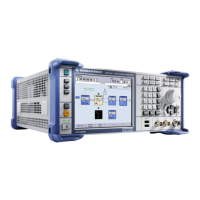Preparing for Use
R&S
®
SMBV100A
27Operating Manual 1407.6062.32 ─ 08
CLOCK OUT
Output for internal clock signal.
While working in synchronous master\-slave mode, the system clock is output on this
connector.
See also chapter 5.8.2.3, "Clock Signals", on page 276.
CLOCK IN
Input for the external (symbol) clock signal for synchronizing the external data signal and
working in synchronous master-slave mode.
See also chapter 5.8.2.3, "Clock Signals", on page 276.
NEXT
This trigger input indicates the next (i.e. the 2nd, 3rd, 4th, ...) segment of a multi segment
waveform, which can be a compound of e.g. a sine, a rectangular, or a sawtooth signal.
TRIGGER
Input for external triggering of digital modulations and standards and ARB and the exter-
nal trigger in synchronous master\slave mode.
SENSOR
Connector for R&S NRP-Zxx sensors.
With the aid of the "User Correction" function, a table with correction values for external
test assemblies can be automatically determined, e.g. for compensating the frequency
response of cables.
The power sensors are connected by inserting the male connector. To disconnect hold
the connector by its sleeve. Pulling on the sensor cable will not release the sensor con-
nector.
See also chapter 5.4.6, "NRP-Z Power Viewer", on page 163.
LO IN, LO OUT
Local oscillator input and output:
●
LO IN: Input for external LO signals
●
LO OUT: Output for internal LO signals.
See also chapter 5.4.5, "Local Oscillator - LO Coupling", on page 161.
IEC 625/IEEE 488
IEC-bus (IEEE 488) interface for remote control of the instrument.
See also chapter A.1, "GPIB Bus Interface", on page 734 and chapter 6.1.6, "GPIB
Interface (IEC/IEEE Bus Interface)", on page 398.
Note: In order to avoid electromagnetic interference (EMI) caused by open lines, always
terminate any connected IEC-bus cable with an instrument or a controller.
Rear Panel Tour

